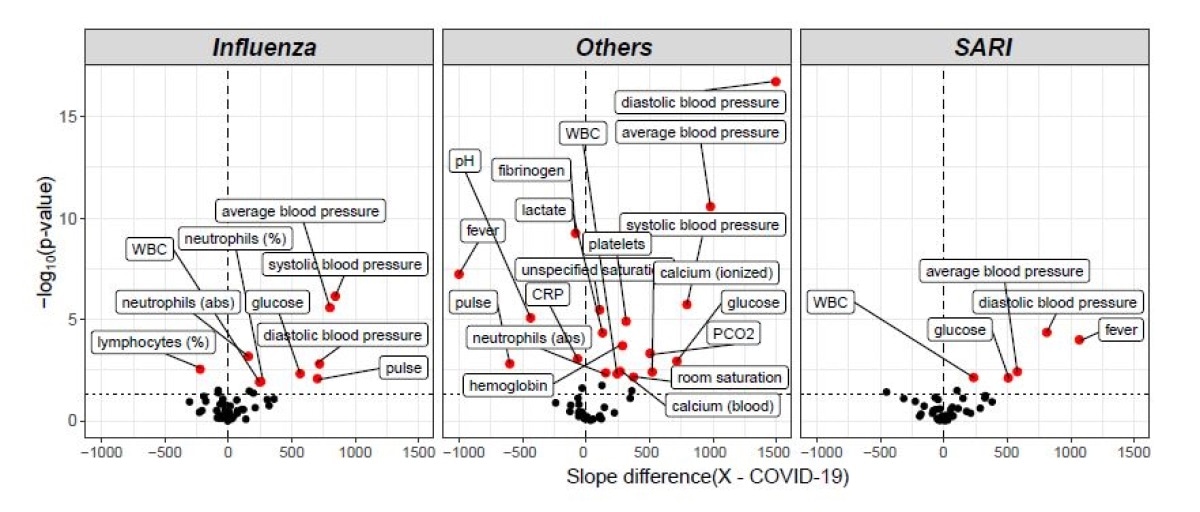A team of scientists from Israel and the United States has compared the disease presentation and progression between in-hospital patients with coronavirus disease 2019 (COVID-19) and other respiratory illnesses such as influenza. Their findings reveal that COVID-19 patients display a unique metabolic, immune, and cardiorespiratory profile and that the severity of COVID-19 is higher than other respiratory infections. The study is currently available on the medRxiv* preprint server.
Severe acute respiratory syndrome coronavirus 2 (SARS-CoV-2) is a highly infectious and deadly virus responsible for the current COVID-19 pandemic. Despite the timely implementation of effective control measures in many countries, SARS-CoV-2 has already infected more than 58.7 million people and claimed more than 1.39 million lives worldwide.
Among various pathological characteristics, COVID-19-associated pneumonia has been recognized as one of the major causes of higher mortality. Because COVID-19 is a newly emerged disease, an in-depth clinical characterization of the disease is a prerequisite to better understand its prognosis.
Because of the upcoming winter season in the Northern Hemisphere, cases of various respiratory infections, including seasonal influenza and severe acute respiratory infection (SARI), are expected to rise, in addition to COVID-19 cases. In this context, evaluating the differences in clinal presentation and progression between COVID-19 and other respiratory illnesses is of prime importance to identify specific COVID-19 features.
Current study design
The scientists analyzed the electronic medical records of patients with various respiratory illnesses admitted to the Rambam Health Care Campus, Israel. They specifically analyzed the patients’ demographic characteristics, vital signs, laboratory findings, and comorbidities. A total of 8,651 patients were included in the study; of which, 693 had COVID-19, 1,612 had influenza, 2,292 had SARI, and 4,054 had other respiratory infections. An in-depth statistical analysis of demographic characteristics, comorbidities, and mortality rates was carried out to determine the disease severity and fatality.
Important findings
Demographic characteristics
The study findings revealed that COVID-19 patients were relatively younger than influenza and SARI patients. Compared to 40% of influenza and SARI patients, only 24% of COVID-19 patients were 75 years or older. Regarding gender distribution, about 58% of SARI patients were male, whereas only 52% and 50% of COVID-19 and influenza patients, respectively, were male. The susceptibility of developing COVID-19 was higher among Arabs compared to influenza and SARI. Although a shorter hospitalization period was noticed in COVID-19 patients in general, moderately or severely affected COVID-19 patients appeared to stay longer in the hospital than influenza or SARI patients.
The proportion of obese people (body mass index >30) was higher among COVID-19 patients compared to influenza and SARI patients. Regarding in-hospital deaths, a significantly higher mortality rate was observed in COVID-19 patients who were moderately or severely affected, and the highest mortality rate was observed for elderly patients ages 65 years or above.
Comorbidities
The presence of various comorbidities, including cancer, pulmonary and cardiovascular problems, and hypertension, was less frequent in COVID-19 patients compared to influenza and SARI patients. However, the incidence of dementia was higher among COVID-19 patients. Importantly, diabetes was found to be associated with severe COVID-19 cases, and an overall high prevalence of diabetes among COVID-19, influenza, and SARI patients indicated that high blood glucose is a common clinical feature for respiratory infections.
Findings at the time of hospitalization
Regarding vital signs, COVID-19 patients showed lower heart rate and systolic blood pressure and higher diastolic blood pressure compared to influenza and SARI patients. However, no significant difference in oxygen saturation, breathing rate, and body temperature was observed between the study groups.

Volcano plot of pairwise post-hoc analysis of patients trajectory of COVID-19, influenza, SARI and others for each lab tests. The level of significance is shown vs. the effect size, namely the slope difference (x - COVID-19). The most highly significant result was for average blood pressure, as seen at the left window, which refers to all influenza-COVID-19 comparisons, and at the right window, which refers to all SARI-COVID-19 comparisons. Trends for WBC, glucose and diastolic blood pressure for COVID-19 patients were found to be different from both influenza and SARI.
Regarding laboratory findings, COVID-19 patients showed lower white blood cell and neutrophil counts and higher lymphocyte count compared to influenza and SARI patients.
Clinical presentation with time
The most notable findings were that COVID-19 patients showed an induction in white blood cell count, neutrophil percentage, and blood glucose level during the first 48 hours of hospitalization, whereas a decreasing trend of these parameters was observed for other patients.
Study significance
The study findings reveal that the majority of hospitalized COVID-19 patients in Israel are younger and have fewer comorbidities compared to other respiratory illness patients. However, a higher mortality rate among moderate to severe COVID-19 patients indicates that the “intrinsic virulence” of COVID-19 is higher than influenza. The study also identifies that COVID-19 patients display a unique cardiovascular, immune, and metabolic signature.

 This news article was a review of a preliminary scientific report that had not undergone peer-review at the time of publication. Since its initial publication, the scientific report has now been peer reviewed and accepted for publication in a Scientific Journal. Links to the preliminary and peer-reviewed reports are available in the Sources section at the bottom of this article. View Sources
This news article was a review of a preliminary scientific report that had not undergone peer-review at the time of publication. Since its initial publication, the scientific report has now been peer reviewed and accepted for publication in a Scientific Journal. Links to the preliminary and peer-reviewed reports are available in the Sources section at the bottom of this article. View Sources